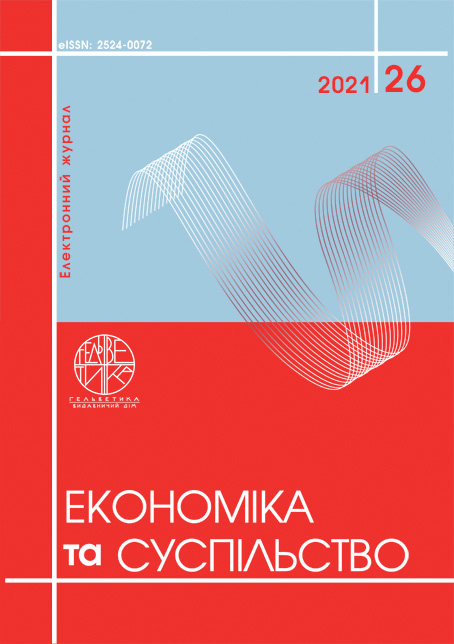EVALUATION OF THE LEVEL OF TOURISM DEVELOPMENT BY QUALIMETRY METHODS
Abstract
The article deals with estimation and comparing the level of tourism development in certain European countries. It is suggested to apply a composite index of the tourism development level in order to provide an overall assessment of the tourism development level. The work emphasises the assessment of perspectives in tourism development from the standpoint of using the country human resources in tourist activity. The comparative analysis has been done, concerning the tourism development in 22 countries of the European region, whose citizens, on the one hand, can be involved in travelling to Ukraine, on the other hand, whose experience can be applied in development of inbound and domestic tourism of Ukraine. Within the current research, six key parameters of tourism development were determined with the help of an expert method: direct input into GDP from tourist activity, the quantity of the world arrivals, tourist expenditure in the country itself, interior tourist consumption, inbound tourism and expenses of international tourists within the country. The generalised index was calculated by the method of qualimetry in two ways. In the first case, to determine the composite index, absolute values of single indicators were chosen, in the second case – their specific values in relation to the country population (re-calculated per head of the population). In both cases, the average values for sampling from 22 countries were chosen as basic indices. The authors applied the differentiated method of assessment to compare single indicators of quality to basic indices. The subjective method was used to calculate the generalised composite index. The research into dynamics of the composite index of tourism development allowed revealing the trends and estimate the time rate of this index for specific European countries. The results of the study showed that application of two approaches for calculating the composite index (on the basis of absolute meanings of primary indicators and their specific value per head of the population) allowed not only comparing the level of tourism development in different countries, but also assess the potential of human resources for tourism development in the country.
References
Руденко В. П., Вацеба В. Я., Соловей Т. В. Природо-ресурсний потенціал природних регіонів України : монографія. Чернівці : Рута, 2001. 268 с.
Черчик Л., Коленда Н. Стратегічний потенціал рекреаційної системи регіону: теорія, методологія, оцінка : монографія. Луцьк : ЛНТУ, 2008. 224 с.
Писаревський І. М., Мелешко К. К. Туристично-рекреаційний потенціал як елемент конкурентоспроможності територій. БізнесІнформ. 2019. №12. С. 148–154.
Марценюк Л.В. Проблеми та перспективи розвитку туризму в Україні. Економічний вісник. 2015. №3. С. 76–82.
Святохо Н.В. Сущность и компоненты туристского потенциала территории. Культура народов Причерноморья. 2006. № 88. С. 95–98.
Михайліченко Г.І. Туристичний потенціал: методи оцінювання та інноваційний розвиток. Проблеми економіки. 2013. № 1. С. 115–123.
Забалдіна Ю.Б., Ліщинський О.Л. Дві адаптивні моделі короткострокового прогнозування туристичних потоків. Стратегія розвитку України (економіка, соціологія, право). 2006. №1. С. 406–410.
Погуда Н.В., Примак Т.Ю., Івченко Л.О. Дослідження чутливості туристичних потоків до впливу світових та локальних факторів. Вчені записки ТНУ ім. В.І. Вернадського. Серія Економіка і управління. 2020. Том 31 (70). № 2. С. 119–124.
Максимюк М.Н. Оценка состояния и перспективы развития индустрии туризма в Украине. Культура народов Причерноморья. 2012. №235. С. 55–61.
Вовк К.М. Управління розвитком подієвого туризму в регіоні: дис. д-ра філософії : 64.055.015 / ХНЕУ ім. С. Кузнеця. Харків, 2021. 264 с.
Світовий атлас даних. Офіційний сайт. Knoema: портал інфографіки. URL: https://bit.ly/3t5AlaU.
Світовий банк. Офіційний сайт. Внесок туризму. URL: https://bit.ly/2PAqLiw.
Всесвітня рада подорожей та туризму. Офіційний сайт. Модель витрат та вигод і технічна доповідь. URL: https://bit.ly/3xvPK7G.
Всесвітня туристична організація. Офіційний сайт. Статистика. URL: https://www.unwto.org/ru/node/116.
Rudenko, V.P., Vatseba, V.Ya.. & Solovey, T.V. (2001). Pryrodo-resursnyi potentsial pryrodnykh rehioniv Ukrainy [Natural resource potential of natural regions of Ukraine]. Chernivtsi: Ruta [in Ukrainian].
Cherchyk, L. & Kolenda, N. (2008). Stratehichnyi potentsial rekreatsiinoi systemy rehionu: teoriia, metodolohiia, otsinka [Strategic potential of the recreational system of the region: theory, methodology, evaluation]. Lutsk: LNTU [in Ukrainian].
Pisarevsky, I.M. & Meleshko, K.K. (2019). Turystychno-rekreatsiinyi potentsial yak element konkurentospromozhnosti terytorii [Tourist and recreational potential as an element of competitiveness of territories]. BiznesInform [BusinessInform], 12. 148-154 [in Ukrainian].
Martsenyuk, L.V. (2015). Problemy ta perspektyvy rozvytku turyzmu v Ukraini [Problems and prospects of tourism development in Ukraine]. Ekonomichnyi visnyk [Economic Bulletin]. 3. 76-82 [in Ukrainian].
Svyatoho, N.V. (2006). Suschnost i komponentyi turistskogo potentsiala territorii [Essence and components of the tourist potential of the territory]. Kultura narodov Prichernomorya [Culture of the peoples of the Black Sea region]. 88. 95-98 [in Russian].
Mikhailichenko, G.I. (2013). Turystychnyi potentsial: metody otsiniuvannia ta innovatsiinyi rozvytok [Tourism potential: evaluation methods and innovative development]. Problemy ekonomiky [Problems of the economy]. 1. 115–123 [in Ukrainian].
Zabaldina, Y.B. & Lishchinsky, O.L. (2006). Dvi adaptyvni modeli korotkostrokovoho prohnozuvannia turystychnykh potokiv [Two adaptive models of short-term forecasting of tourist flows]. Stratehiia rozvytku Ukrainy (ekonomika, sotsiolohiia, pravo). [Development strategy of Ukraine (economics, sociology, law)]. 1. 406–410 [in Ukrainian].
Pohuda, N.V., Prymak, T.Yu. & Ivchenko, L.O. (2020). Doslidzhennia chutlyvosti turystychnykh potokiv do vplyvu svitovykh ta lokalnykh faktoriv [Research of sensitivity of tourist flows to effects of world and local factors]. Vcheni zapysky TNU im. V.I. Vernadskoho. Seriia Ekonomika i upravlinnia [Scientific notes of TNU. V.I. Vernadsky. Series Economics and Management.]. 31 (70). 2. 119-124.
Maksimyuk, M.N. (2012). Otsenka sostoyaniya i perspektivyi razvitiya industrii turizma v Ukraine [Assessment of the state and prospects for the development of the tourism industry in Ukraine]. Kultura narodov Prichernomorya [Culture of the peoples of the Black Sea region]. 235.55-61 [in Russian].
Vovk, K.M. (2021). Upravlinnia rozvytkom rodiievoho turyzmu v rehioni [Management of the development of rhodium tourism in the region]. PhD thesis. Kharkiv [in Ukrainian].
World data atlas (2021). Knoema: portal of infographics. Available at: https://bit.ly/3t5AlaU.
World Bank (2021). Direct contribution of tourism. Available at: https://bit.ly/2PAqLiw.
WTTC (2021). Cost-benefit model and technical report. Available at: https://bit.ly/3xvPK7G.
UNWTO (2021). Statistics. Available at: https://www.unwto.org/ru/node/116.


